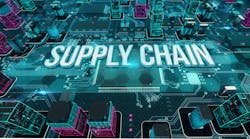Download this article in PDF format.
As they continue to manage the impacts of the global pandemic and prepare themselves for the post-COVID world, supply chain leaders are integrating more technology into their global networks, according to a new report from Gartner Research.
Highlighting what it sees as the “Top 8 Supply Chain Technology Trends for 2020,” the research firm points to artificial intelligence (AI), edge computing and supply chain governance as some the top-of-mind trends for supply chain leaders that want to transform their organizations.
“It is important for supply chain technology leaders to adapt a mindset that accepts and embraces long-term perpetual change,” Gartner’s Christian Titze points out. “[Our] research shows that supply chain leaders perceive technology primarily as a competitive advantage — they focus on long-term value. Yet, 80% of organizations favor a cautious approach when it comes to adopting new supply chain applications and technologies.”
Here are some of the top trends that Gartner says all supply chain organizations should be exploring and potentially implementing in 2020 (read the full list here):
Supply chain governance and security. Calling this “an increasingly important macro trend,” Gartner says it’s particularly crucial in a business environment where global risk events are accelerating and where security breaches impact companies at both the digital and physical levels. “Gartner anticipates a wave of new solutions to emerge for supply chain security and governance, especially in the fields of privacy as well as cyber and data security,” Titze says. “Think advanced track-and-trace solutions, smart packaging, and next-gen RFID and NFC (near-field communications) capabilities.”
Edge computing and analytics. Computing that's done at or near the source of the data, edge computing’s growth coincides with the proliferation of Internet of Things (IoT) devices. “It’s the technology needed when there is a demand for low-latency processing and real-time, automated decision making,” says Gartner, noting that edge computing is now making its way into the manufacturing industry. For example, some organizations have adopted driverless forklifts for their warehouses, while heavy equipment sellers can use edge computing to analyze when a part needs maintenance or replacement.
Artificial intelligence. Right now, AI in supply chain consists of a toolbox of technology options that helps companies understand complex content, engage in natural dialogue with people, enhance human performance and take over routine tasks. “Currently, AI helps supply chain leaders solve longstanding challenges around data silos and governance,” Gartner says. “Its capabilities allow for more visibility and integration across networks of stakeholders that were previously remote or disparate.”
Digital supply chain twins. A digital supply chain twin (DSCT) is a digital representation of the physical supply chain and is derived from all relevant data across the supply chain and its operating environment. DSCT is the basis for all local and end-to-end decision making. “DSCTs are part of the digital theme that describes an ever-increasing merger of the digital and physical worlds,” Titze says. “Linking both worlds enhances situational awareness and supports decision making.”
Hyperautomation. This is a framework for mixing and matching an array of technologies in the best possible way (i.e., historic legacy platforms with recently deployed tools and planned investments). The term means different things for different organizations, so supply chain leaders must first find their individual definition. “If deployed correctly,” Gartner says, “hyperautomation can encourage broader collaboration across domains and act as an integrator for disparate and siloed functions.”
Continuous intelligence. Gartner sees this as one of the biggest opportunities for supply chain leaders to accelerate their organizations’ digital transformation. That’s because continuous intelligence leverages a computer’s ability to process data at a much faster pace than people can. “Supply chain leaders or other systems,” it says, “can look at the processed data, understand what is happening, and take action immediately.”
Despite being under pressure to reduce costs and/or prove short-term return on investment (ROI), Gartner says supply chain technology leaders should adapt a mindset that accepts and embraces long-term perpetual change. Using the top strategic supply chain technologies outlined in the firm’s report, companies can make the best decisions about their tech investments, implementations and usage.









